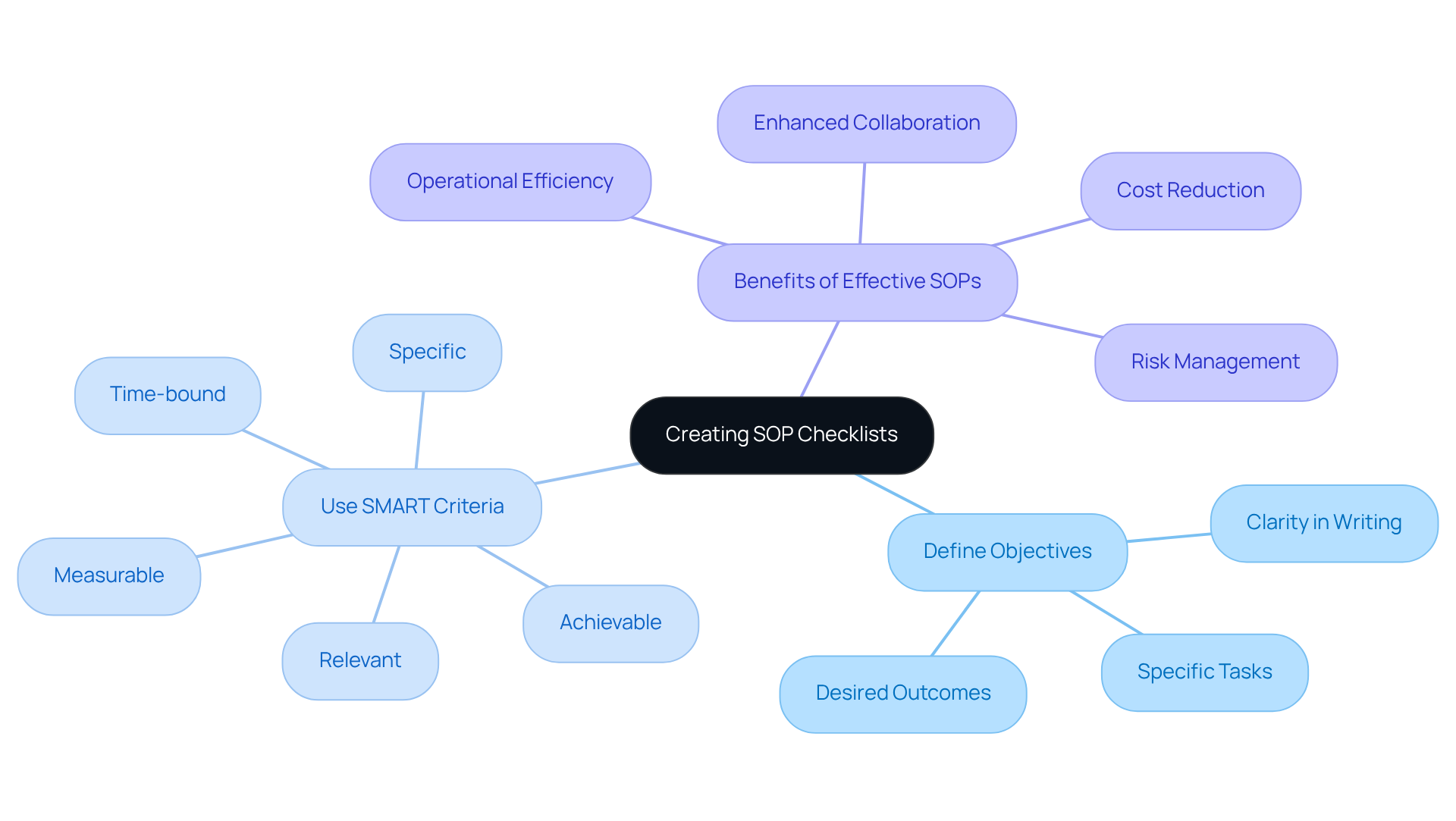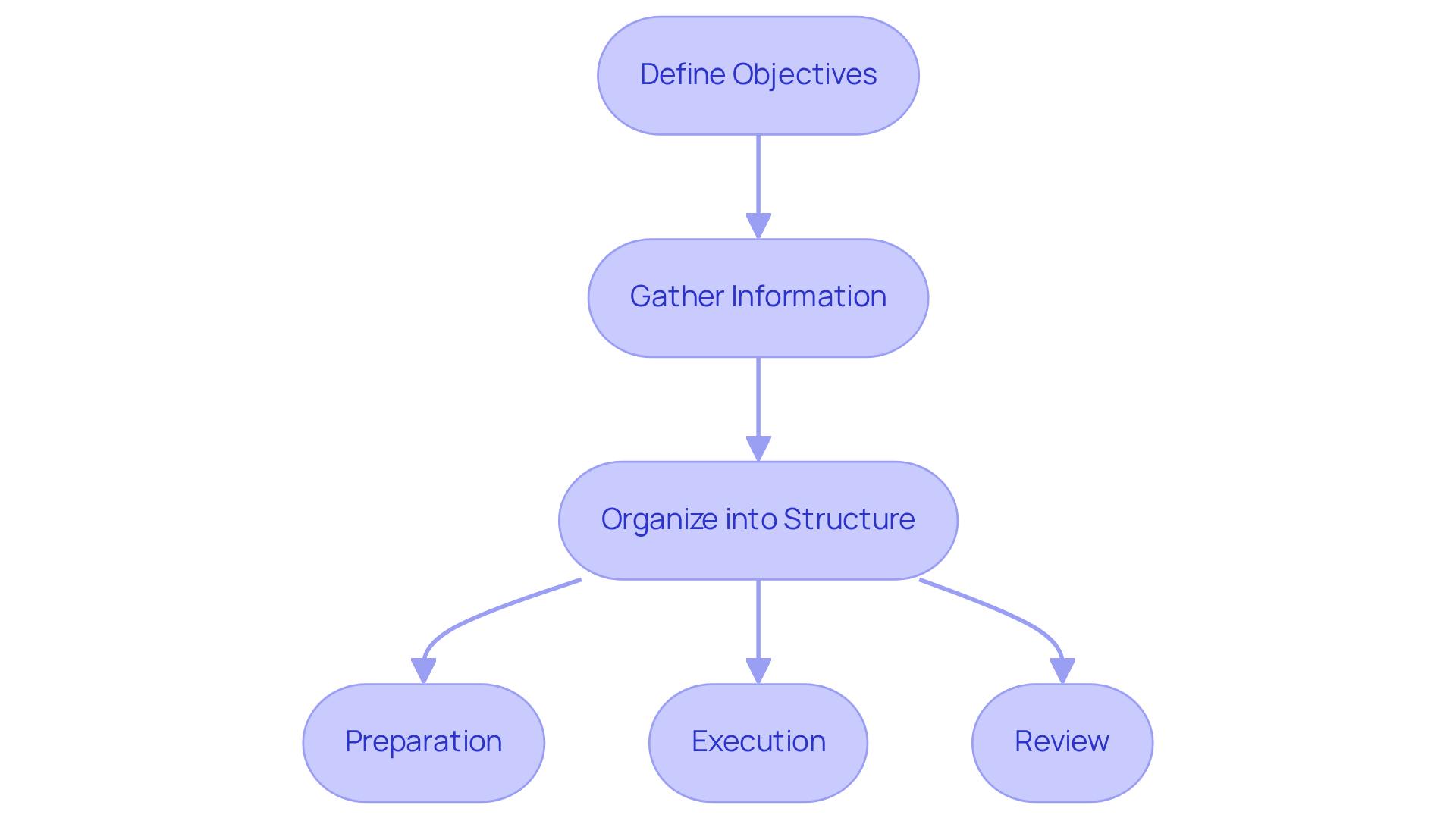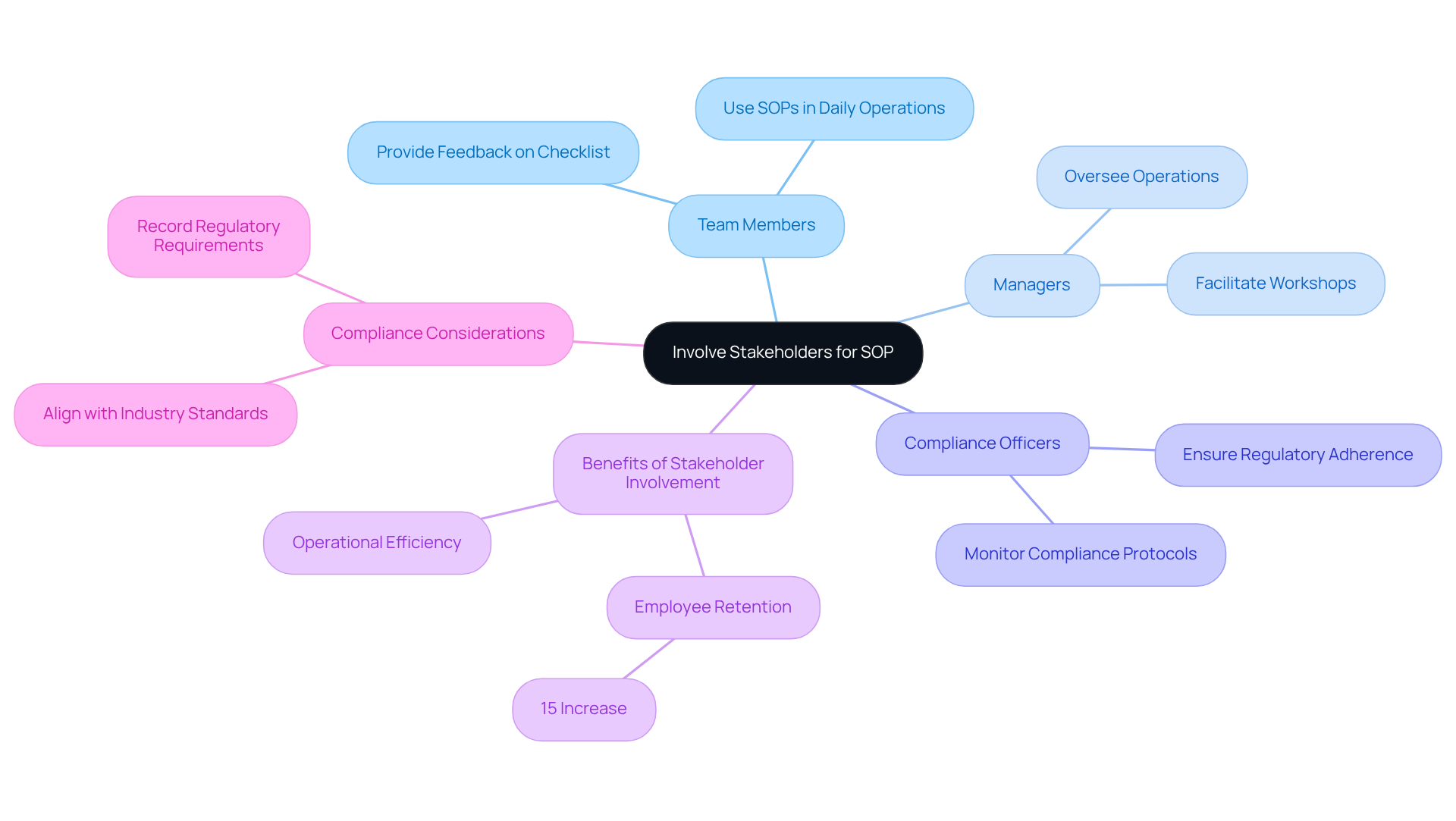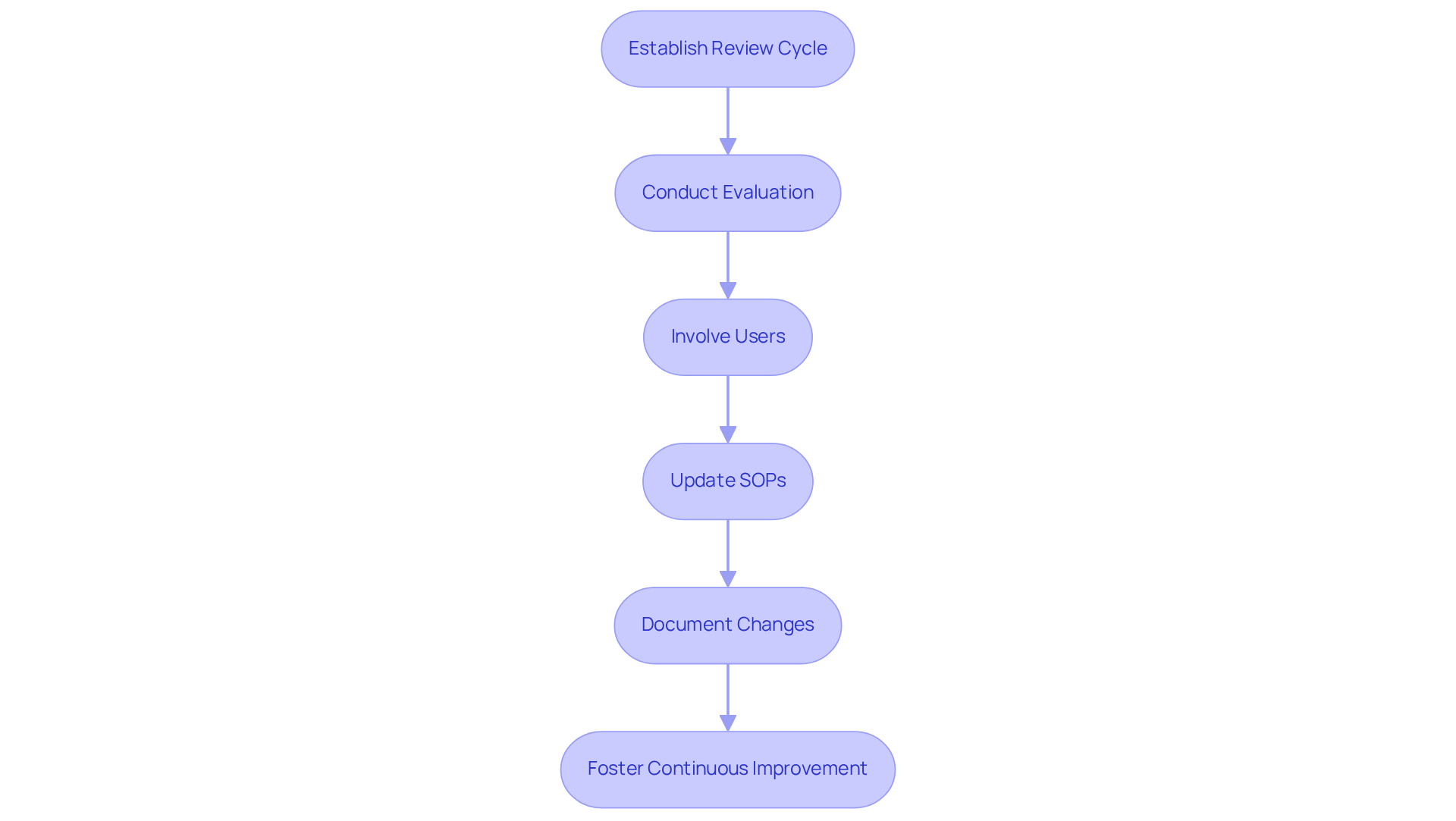
Process Improvement through Documentation
|
October 16, 2025
|
4 Steps to Create an Effective Standard Operating Procedure Checklist
Overview
You might be wondering how to create an effective Standard Operating Procedure (SOP) checklist. Well, it all starts with clearly defining your objectives using SMART criteria. Next, gather relevant information, involve your stakeholders, and establish a regular review cycle. These steps really help enhance clarity, compliance, and operational efficiency. Ultimately, they lead to better organizational performance and risk management. So, why not dive into these tips and see how they can make a difference for you?
Key Highlights:
- Define clear objectives and purpose for the SOP to guide its development and ensure team understanding.
- Utilise SMART criteria (Specific, Measurable, Achievable, Relevant, Time-bound) to sharpen objectives and enhance focus.
- Gather relevant information from subject matter experts and existing documentation to inform the SOP structure.
- Organise tasks into logical phases (e.g., Preparation, Execution, Review) to boost clarity and usability.
- Incorporate visual aids like flowcharts to simplify complex processes and enhance user-friendliness.
- Involve stakeholders (users, managers, compliance officers) to gather diverse insights and foster collaboration.
- Ensure compliance with industry standards by integrating regulatory requirements into the SOP checklist.
- Establish a regular review cycle (quarterly or biannual) to keep SOPs updated and aligned with current practises.
- Document the review process and any changes made for regulatory audits and continuous improvement.
Introduction
Creating a standard operating procedure (SOP) checklist isn’t just another task on your to-do list; it’s a smart move that can seriously boost your organization’s efficiency. You might be wondering how defining clear objectives and getting key stakeholders involved can make a difference. Well, by doing just that, companies can whip up SOPs that not only streamline operations but also improve compliance and foster collaboration.
But here’s the real question: how can organizations keep these checklists relevant and effective over time? Let’s dive into some essential steps for developing impactful SOP checklists, offering insights that could elevate your operational standards and pave the way for success.
Define Objectives and Purpose for SOP Checklists
You might be wondering how to create an effective standard operating procedure checklist. Well, the first step is to clearly define the objectives and purpose of the SOP. Think about what specific tasks you want the SOP to tackle and what outcomes you hope to achieve. For example, if your goal is to simplify onboarding procedures, make sure to outline the key steps that new employees need to follow. This clarity not only guides your writing but also helps everyone on the team understand why following the SOP is so important.
Now, let’s talk about using SMART criteria—Specific, Measurable, Achievable, Relevant, and Time-bound. This approach can really sharpen your objectives. Recording the purpose right at the start of your SOP guide keeps you focused during the development process, leading to more effective and actionable SOPs. Plus, having well-defined objectives is crucial for risk management and compliance with industry regulations. It helps organizations anticipate potential risks.
And here’s something to think about: the operational efficiency you gain from effective SOPs can directly boost your profitability. Not to mention, they promote better collaboration and coordination between departments. As Peter Drucker famously said, 'What gets measured gets managed.' This really highlights the importance of having clear objectives to achieve successful outcomes. So, are you ready to dive into creating your very own standard operating procedure checklist?

Gather Information and Determine Structure
To create an effective standard operating procedure checklist, you may be wondering where to start. First things first: clearly define your objectives. After that, gather all the relevant information. This could mean chatting with subject matter experts, checking out existing documentation, or even observing current procedures in action. Once you have everything, organize it into a logical structure that reflects the workflow. For example, think about categorizing tasks into phases like:
- Preparation
- Execution
- Review
This organized approach not only boosts clarity but also helps users navigate the list more easily.
Speaking of making things easier, consider incorporating visual aids like flowcharts or diagrams. They can really simplify complex processes, making your SOP more user-friendly. Research shows that using a standard operating procedure checklist can significantly enhance adherence and operational efficiency. So, it's clear that a well-organized list is not just a nice-to-have—it's essential for success!

Involve Stakeholders and Ensure Compliance
You might be wondering why involving key stakeholders in creating the SOP document is so important. Well, it’s all about gathering a diverse array of perspectives and insights! This group should include:
- Team members who will actually use the SOP
- Managers who oversee operations
- Compliance officers tasked with ensuring everyone follows the rules
Conducting workshops or interviews can really help in getting feedback on the proposed checklist structure and content, fostering a sense of collaboration and ownership among everyone involved. Plus, organizations that bring stakeholders into the mix can see a 15% rise in employee retention—talk about a win-win!
Now, let’s dive into how to make sure that the SOP aligns with industry standards and regulations. Reviewing relevant guidelines during the development process is crucial. By recording regulatory requirements within the checklist, you not only highlight their importance but also help users stick to them. As Paul Koziarz puts it, "Without adherence to regulations, many organizations wouldn’t have security controls in place," which really drives home the necessity of these frameworks. By integrating stakeholder feedback and compliance considerations, organizations can whip up SOPs that boost operational efficiency and reduce risks. This ultimately leads to improved performance and satisfaction all around. And here’s something to think about: 85% of stakeholders feel that engagement significantly influences their perception of organizational transparency. So, the importance of stakeholder feedback in crafting effective SOPs really can’t be overstated!

Review and Update SOP Checklists Regularly
You might be wondering how to keep your SOP documents fresh and relevant. Establishing a regular review cycle is key! Aim for quarterly or biannual evaluations, depending on how complex the tasks are. During these check-ins, take a moment to see if your list still aligns with current practices and regulatory requirements.
Involving users, like Subject Matter Experts (SMEs) and frontline staff, is super important. Their insights can highlight areas that need a little polishing or clarification. If there are big changes in procedures or regulations, don’t wait—update your SOP checklist right away to reflect those changes. And remember, documenting the review process and any tweaks you make creates a clear record of changes, which is crucial for regulatory audits.
Organizations that make regular updates a priority foster a culture of continuous improvement. This not only boosts operational efficiency but also helps with compliance. For instance, companies that have set up structured review cycles often see a significant drop in audit findings related to non-compliance. That’s proof that keeping your SOPs up-to-date really pays off! Plus, using simple language in your SOPs can make it even easier for everyone to understand and follow along.

Conclusion
Creating an effective standard operating procedure (SOP) checklist is super important for making sure everything runs smoothly in any organization. You might be wondering how to go about it, right? Well, by following a few simple steps—like:
- Defining your objectives
- Gathering the right info
- Involving your team
- Regularly reviewing those SOPs
You can whip up checklists that not only streamline processes but also boost collaboration and accountability among your team members.
Let’s talk about why setting clear objectives is key. Using SMART criteria can really help guide you in developing your SOPs. And don’t forget to gather all the relevant information and structure your checklist logically! This makes it way easier to use. Engaging stakeholders throughout the process means you get to consider diverse perspectives while also keeping in line with industry regulations. Plus, regular reviews and updates are crucial for keeping those SOPs fresh and effective, which ultimately leads to better performance for the whole organization.
In conclusion, the importance of a well-crafted SOP checklist really can’t be overstated. It’s like the backbone of operational success and fosters a culture of continuous improvement. So, organizations should definitely prioritize creating and maintaining these checklists. They’re essential for navigating complexities and achieving the results you want. By committing to these best practices, you’ll not only enhance efficiency but also empower your teams to work together more effectively and collaboratively. Sounds like a win-win, doesn’t it?
Frequently Asked Questions
What is the first step in creating an effective standard operating procedure (SOP) checklist?
The first step is to clearly define the objectives and purpose of the SOP, focusing on specific tasks and desired outcomes.
How can SMART criteria help in defining objectives for SOPs?
SMART criteria—Specific, Measurable, Achievable, Relevant, and Time-bound—can sharpen your objectives and keep you focused during the development process, leading to more effective and actionable SOPs.
Why is it important to outline the purpose at the start of an SOP?
Outlining the purpose at the start helps maintain focus during development and ensures that the SOP is aligned with achieving specific outcomes.
How do well-defined objectives contribute to risk management?
Well-defined objectives are crucial for risk management as they help organizations anticipate potential risks and ensure compliance with industry regulations.
What are some benefits of effective SOPs for organizations?
Effective SOPs can boost operational efficiency, enhance profitability, and promote better collaboration and coordination between departments.
What famous quote emphasizes the importance of having clear objectives?
Peter Drucker’s quote, "What gets measured gets managed," highlights the significance of having clear objectives to achieve successful outcomes.
👍
What others are liking
5 Steps to outline your ideal documentation structure
5 MINS READ
Where to start the your journey of mapping out your ideal documentation structure, aligning it with the very heartbeat of your organization?
Defining a winning level of detail in your process
3 MINS READ
What is too much detail, and what is too little? This article described in that winning level detail about what detail is enough.





